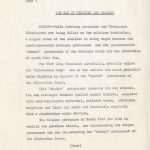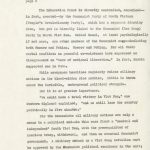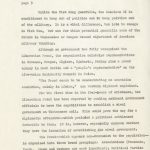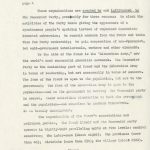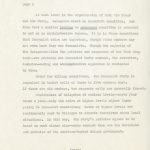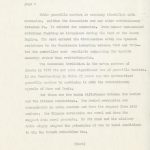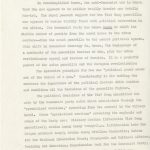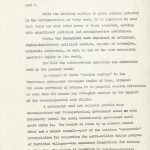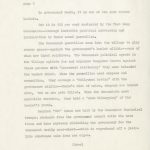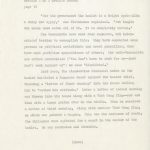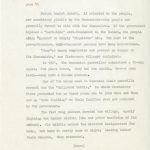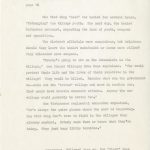1964, October, “The War of Termites and Shadows”
Deepe
article 2 of seven article series
page 1
THE WAR OF TERMITES AND SHADOWS
SAIGON–While American sergeants and Vietnamese lieutenants are being killed on the military battlefield, a higher level of the conflict is being waged between the American-backed national government and the pro-Communist “shadow” government of the National Front for the Liberation of South Viet Nam.
The Viet Cong Communist guerrillas, actually called the “Liberation Army” are on the surface the armed guerrilla units fighting in support of the “shadow” government of the Liberation Front.
This “shadow” government operates its own schools, its own strategic hamlets (called combat hamlets, complete with anti-helicopter defenses), collects taxes, maintains hospitals and first aid wards and broadcasts regularly from a clandestine radio station.
The 40-plus provinces of South Viet Nam have in reality two province chiefs, one representing the Saigon government and one representing the “shadow” government of the Liberation Front.
(More)
deepe
article 2 of seven article series
page 2
The Liberation Front is directly controlled, organized–in fact, created–by the Communist Party of South Vietnam (People’s Revolutionary Party), which has a separate identity from, but yet is directly linked to the Communist (Lao Dong) Party in North Viet Nam. Behind Hanoi, at least psychologically if not more, are other members of the Communist camp–including both Moscow and Peking. Moscow and Peking, for all their verbal conflicts on peaceful co-existence have expressed no disagreement on “wars of national liberation.” In fact, Russia supported one in Cuba. While newspaper headlines regularly relate military actions in the blood-ridden rice paddies, little is known about the invisible, underground political struggle.
But it is of greater importance.
“We could have a total victory in Viet Nam,” one Western diplomat explained, “and still lose the country politically in five minutes.”
For the Communists all military actions are only a means to a political end–in this came first a “neutral and independent” South Viet Nam, with the prerequisites of American troop, withdrawal, and then an eventual Communist government. A military acttack by a Viet Cong battalion must be approved by the Communist political commissar in the unit; the individual guerrilla is first a political expert and second a guerrilla. He is taught Communist doctrine before he is taught how to shoot a gun.
(More)
deepe
article 2 of seven article series
page 3
Unlike the Viet Cong guerrilla, the American GI is conditioned to keep out of politics and rto keep politics out of the military. It is a vital difference, too late to change in Viet Nam, but one for which potential guerrilla wars of the future in Venezuelas or Congos demand adjustment of American military thinking.
Although no government has fully recognized the Liberation Front, the organization maintains representatives in Havanna, Prauge, Algiers, Djakarta, Peking plus a press agency in East Berlin and a “people’s representative” on the Afro-Asian Solidarity Council in Cairo.
“The Front seems to be concentrating on non-Asian countries, mainly in Africa,” one Western diplomat explained.
For the first time in its four-years of existence, the Liberation Front has been reported by ranking national government officials to have the capabilities to establish a rival government on Vietnamese soil. This would pave the way for a diplomatic offensive–which preluded a political settlement favorable to them. It is, however, reportedly unknown whether they have the intention of establishing the rival government.
The Front–which appears non-Communist to the population–is organized into three broad groupings: Associations (Peasants, Youth, Women and Workers are most important); Political Parties (Democratic and Socialist Party, both non-Communist, and the Communist Party); and the Youth League (comparable to Komsomol in Communist nations). (More)
deepe
article 2 of seven article series
page 4
These organizations are created by and infiltrated by the Communist Party, preslumably for three reasons: to cloak the activities of the Party hence giving the appearance of a spontaneous people’s uprising instead of organized Communist-directed subversion; to recruit members from the Front and train them for Party membership; to gain cooperation of non-Cpommunist, but anti-government intellectuals, workers and other elements.
To the side of the Front is the “Liberation Army,” now the world’s most successful guerrilla movement. The Communist Party is the dominating part of Front and the Liberation Army in terms of leadership, but not necessarily in terms of numbers. The face of the Front is open to the population, but not to the government; the face of the Liberation Army is open to the population–and to the government in battle; the Communist party is secret, their activities clandestine to both the government and the population–and sometimes to members themselves. It is totally underground.
The organization of the Front’s associations and political parties, the Front itself and the Communist party operate in tightly-knit paralleling units at five levels: central committee; the inter-zone (about eight); the provinces (more than 40); districts (more than 250); the village (about 2500).
(More)
deepe
article 2 of seven article series
page 5
At each level in the organization of both the Front and the Party, delegates elect an executive committee, and from that a smaller leading or permanent committee is selected to act as an administrative bureau. It is in these committees that Communist cadre are important, though other members may not even know they are Communists. Though the majority of the delegates–like the privates and sergeants of the Viet Cong Army–are probably not Communist Party members, the executive, decision-making and administrative apparatus is dominated by them.
Below the village committees, the Communist Party is organized in hamlet cells of three to five members each. If there are six members, two separate cells are generally formed.
Conferences of delegates at various levels–maybe four times a year–help the cadre at higher levels adjust their policy to rice-root conditions; cadre at higher levels are continuously sent to villages to educate themselves about local situations. In this way, the Party’s policies appear to be based on much closer rice-roots contact than are the decisions and policies of the American-backed Saigon government.
Deepe
article 2 of seven article series
page 6
While guerrilla warfare is commonly identified with Communism, neither the Communists nor any other revolutionary invented it. It existed for centuries. Even Caesar encountered civilians fighting as irregulars during the days of the Roman Empire. The word entered the dictionaries after the Spanish resistance to theNapoleanic invasion between 1808 and 1813–but the guerrillas were royalists supporting the Spanish monarchy rather than revolutionaries.
The Communist Revolution in the urban centers of Russia in 1917 did not make significant use of guerrilla tactics. It was Mao-Tse-Tung in China 25 years ago who systematized guerrilla warfare by combining it with the revolutionary appeals of Marx and Lenin.
But there are two basisc differences between the Soviet and the Chinese revolutions. The Soviet revolution was concentrated in urban centers and drew its support from city workers; the Chinese revolution was rural and drew its support from rural peasants. Ho Chi Minh and his military aids simply adapted the principles ofMao to local conditions to win the French Indo-China War.
(More)
deepe
article 2 of seven article series
page 7
In oversimplified terms, the anti-Communist war in South Viet Nam now appears to be neither totally Marxist nor totally Mao-ist. The rural peasants support for the Viet Cong guerrillas now appears to become visibly fused with political subversion in the cities. The Communist Party has hence began to shift its visible center of gravity from the rural areas to the urban centers–from the armed guerrilla to the secret political agents. This shift in Communist strategy is, hence, the beginnings of a synthesis of the guerrilla tactics of Mao, plus the urban revolutionary appeal and tactics of Marxism. It is a powerful packet of the Asian guerrilla and the European revolutionary.
The operative principle for Mao was “political power comes out of the barrel of a gun.” Consistently in his writing Mao stresses the importance of the political factors which cushion and condition all the decisions of the guerrilla fighter.
The political decisions of the Viet Cong guerrillas are made by the Communist party cadre which administers through ten “specialized sections,” operating from the central to the village level. These “specialized sections” revealing the emphasis and scope of the Party are: Military Sections (Liberation Viet Cong guerrillas); Action Among Enemy Troops(i.e. infiltration into the Saigon national army); Action Among Civilian Population; Action for the National Liberation Front; Propaganda and Cultural Affairs; Training and Education; Organization Work for the Communist Party; Economic and Financial Affairs; Communication and Liaison; Security and Public Order.
(More)
deepe
article 2 of seven article series
page 8
While the military section is given primary priority in the administration of Party work, it is important to note that there are nine other areas of Party interest, dealing with significant political and administrative activities.
Hence, the Communists have organized an efficient, highly-indoctrinated political machine, capable of extensive, invisible subversion, as well as one of the most successful guerrilla armies in the world.
How does the inter-related guerrilla and subversive work at the peasant level?
An example of their “termite warfare” is the Vietnamese government strategic hamlet of Cana, situated 130 miles northeast of Saigon. It is peaceful seaside collection of more than 400 houses for 1000-plus workers in the largest of the French-operated salt fields.
A government road and railroad provide easy communications and transportation; government scout ar cars frequently patrol the area; occasionally government naval craft slide in. The hamlet is ruled by an elected hamlet chief and a hamlet council–part of the American “democratic” prerequisites for supporting the multi-million dollar program of fortified villages–the announced foundations for victory in Viet Nam. The hamlet is protected by American-supplied barbed wire; it is defended by more than 20 American-armed hamlet militia.
(More)
deepe
article 2 of seven article series
page 9
In government books, it is one of the most secure hamlets.
But it is 100 per cent dominated by the Viet Cong Communists–through invisible political subversion and intimidation by their armed guerrillas.
The Communist guerrillas come into the village to play soccer games–against the government’s hamlet militia–some of whom are blood relatives. The Communist political agents in the Village agitate for and organize Kangaroo Courts against those persons with “incorrect attitude;” they once beheaded the hamlet chief. When the guerrillas need weapons and ammunition, they arrange a “Hollywood battle” with the government militia–there’s alot of noise, weapons are handed over, but no one gets killed. When the Communists need guerrilla recruits, they hold a “mock kidnapping” of the hamlet’s youth.
Regular “USO” shows are held by the Communist theatrical troupe; students from the government school write the news items and draw cartoons ridiculing the government for the Communist weekly news-sheet–which is reproduced off a jelly-like substance made from sea algae.
(More)
deepe
article 2 of seven article series
page 10
“For the government the hamlet is a bright spot–like a shiny red apply ,” one Vietnamese explained. “But inside the worms have eaten all of it. It is completely rotten.”
The Communists have used four separate, but inter-related tactics to accomplish this: they have converted some persons as political activists and armed guerrillas, they have made part-time sympathizers of others; the anti-Communists are either neutralized (“You don’t have to work for us–just don’t work against us”) or else “liquidated.”
Last year, the clandestine Communist cadre in the hamlet initiated a Kangaroo Court against the hamlet chief, throwing a “letter of first warning” into his house telling him to “Review his attitude.” Later a letter of second warning was thrown into his house along with a Viet Cong flag–red and blue with a large golden star in the middle. Then he received a letter of third warning, along with another Viet Cong flag, on which was painted a dagger. This was the sentence of death. The villagers were agitated for a court in the center of the hamlet. He was convicted and beheaded.
(More)
deepe
article 2 of seven article series
page 11
Future hamlet chiefs, if selected by the people, are considered pliable by the Communists–the people are generally forced to side with the Communists. If the government imposes a “hard-line” anti-Communist on the hamlet, the people again “uprise” or simply “liquidate” him. But most of the pro-government, anti-Communist persons have been neutralized.
“They’re human vegetables and present no danger to the Communists,” one Vietnamese villager explained.
In 1961, the Communist guerrillas maintained a 12-man squad. Two years later, they had two squads. Now–a year later–they have a 45-man platoon.
One of the means used to increase their guerrilla strength was the “Hollywood battle,” in which Communists first persuaded two or three young men to join them and then set up “mock fighting” so their families were not punished by the government.
The Viet Cong platoon invaded the village, openly fighting the hamlet militia (who had prior knowledge of the attack). The militia called the district headquarters for help, but knew it rarely came at night. Leaving behind their weapons, they retreated.
(More)
deepe
article 2 of seven article series
page 12
The Viet Cong “held” the hamlet for several hours, “kidnapping” the village youth. The next day, the hamlet defenders returned, reporting the loss of youth, weapons, and ammunition.
The district officials were suspicious, but helpless: should they leave the hamlet undefended or issue more rifles? They allocated more weapons.
“Nobody’s going to rat on the Communists in the village,” one former villager from Cana explained. “Who would protect their life and the lives of their relatives in the village? They would be killed. Besides what can the government do–take out the “rotten” village and move in another one. That would have drastic economic effects. Anyway the new village would probably be rotten too.”
One Vietnamese regimental commander explained, “It’s always the quiet places where the most is happening. The Viet Cong don’t have to fight in the villages they already control. Nobody sees them or hears what they’re doing. They just busy little termites.”
Tomorrow: “Silver Race vs. the “Black” Race
Dear Mssrs. Wald and Rosenfeld:
This is a fairly long piece, and maybe a little esoteric, but no one has written a piece about the political organizations and its relationship to the Viet Cong guerrillas–or the emphasis on subversion. I Think it’s very important and will become increasingly so in case the Party begins a diplomatic offensive.
I’ve previously sent you some photos of V.C. prisoners and some graphs that illustrate this article.
Sincerely
Beverly Deepe
Read Previous Article: 1964, September, “Astrologers and Fortunetellers in this Year of the Dragon”
Read Next Article: 1964, October, “The “Silver” Race vs. The “Black” Race”

